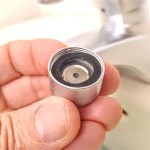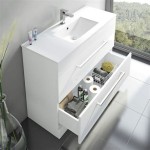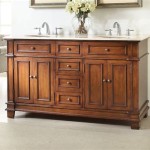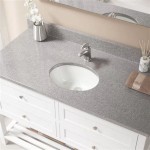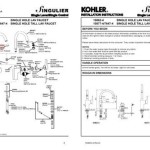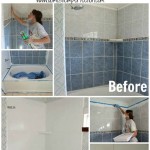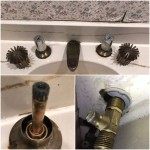Understanding "B Quality" Vanity Unit Bathroom Suites
The term "B Quality" when applied to vanity unit bathroom suites signifies products that possess minor imperfections or cosmetic flaws. These imperfections typically do not affect the functionality or structural integrity of the unit but render them unsuitable for sale as "A Quality" or "First Quality" items. Consumers considering a B Quality vanity unit bathroom suite can often secure significant cost savings compared to purchasing a pristine, flawless unit. However, a thorough understanding of what constitutes "B Quality" and the associated considerations is essential before making a purchase.
The bathroom vanity unit serves as a central element in bathroom design, combining a sink, storage, and often a countertop in a single, cohesive piece of furniture. These units are available in diverse styles, sizes, and materials to suit various aesthetic preferences and spatial constraints. A complete bathroom suite, in addition to the vanity unit, usually includes a toilet and sometimes a bathtub or shower enclosure, creating a coordinated and harmonious bathroom environment. While acquiring a full suite offers aesthetic benefits, focusing on the vanity unit's quality, even within the "B Quality" designation, remains paramount due to its frequent use and visual prominence.
When considering a B Quality vanity unit bathroom suite, a clear understanding of the types of imperfections one might encounter is crucial. These imperfections vary in severity and visibility, and a prospective buyer should carefully evaluate their tolerance for these flaws in relation to the price reduction offered.
Types of Imperfections in B Quality Vanity Units
The imperfections found in B Quality vanity units generally fall into several categories. Understanding these categories helps consumers assess the potential impact on the unit's overall aesthetics and functionality.
Surface Scratches and Dents: These are perhaps the most common types of imperfections. They may appear on the cabinet doors, drawers, or countertop. The severity can range from barely noticeable hairline scratches to more prominent dents caused by minor impacts during manufacturing, handling, or transportation. The location of the scratch or dent also influences its impact. A small scratch on the inside of a cabinet door is less significant than a dent on the countertop's edge.
Paint or Finish Imperfections: These include inconsistencies in the paint application, such as uneven coverage, drips, or blemishes. Color variations between different components of the unit are also possible. Similarly, the finish, whether it's a gloss, matte, or textured surface, might have imperfections like bubbles, orange peel texture, or areas where the finish has been chipped or scratched.
Chipboard Damage: Many vanity units are constructed using chipboard, also known as particleboard, as a core material. Exposure to moisture can cause chipboard to swell or delaminate. B Quality units might exhibit minor water damage in discreet areas. Additionally, the veneer or laminate applied to the chipboard might have imperfections such as peeling edges or bubbling.
Hardware Issues: The hinges, handles, drawer slides, and other hardware components may be scratched, tarnished, or missing screws. In some cases, the hardware might be slightly misaligned, causing drawers or doors to stick or not close properly. Before purchasing, it's crucial to inspect the functionality of all hardware components.
Countertop Imperfections: If the vanity unit includes a countertop, it might have chips, cracks, or stains. Quartz, marble, or granite countertops are less common in B Quality units due to their higher cost. Laminate or solid surface countertops are more typical, and their durability varies. A chip on the edge of a countertop is more problematic than a stain that can potentially be cleaned.
Dimensional Discrepancies: In rare cases, there might be slight dimensional discrepancies, where the components are not perfectly aligned or the overall dimensions deviate slightly from the advertised specifications. This is more likely to occur in units that have been damaged during assembly or transport. Thorough measurement is recommended to ensure the unit fits the intended space.
Advantages of Purchasing B Quality Vanity Unit Bathroom Suites
The primary advantage of acquiring a B Quality vanity unit bathroom suite is the significantly reduced cost compared to first-quality units. This cost saving allows consumers to either allocate budget to other aspects of the bathroom renovation or to afford a higher-specification unit that would otherwise be financially out of reach. A careful assessment of the imperfections present in the unit is crucial to ensure the cost savings are justified and that the imperfections are tolerable.
Another potential advantage is the opportunity for customization. Since the unit is already discounted due to imperfections, consumers might feel more comfortable making alterations or enhancements to suit their specific needs and preferences. This could involve replacing the hardware, repainting the cabinet, or even replacing the countertop. The lower initial cost provides greater flexibility to personalize the unit. The environmental impact of purchasing a B Quality unit can also be viewed as an advantage. By opting for a slightly imperfect item, consumers are preventing it from ending up as waste, contributing to a more sustainable approach to home improvement.
Furthermore, the imperfections might be located in areas that are not readily visible after installation. Scratches on the inside of cabinet doors, for example, are unlikely to be noticed on a daily basis. Similarly, if a unit requires minor repairs or touch-ups, the cost of these repairs might still be less than the difference in price between the B Quality unit and a first-quality alternative.
Key Considerations Before Purchasing
Purchasing a B Quality vanity unit bathroom suite requires careful evaluation and detailed inspection. Failing to do so can lead to dissatisfaction and potentially negate the cost savings. Several key considerations should be taken into account.
Firstly, a thorough inspection of the unit is essential. This includes carefully examining all surfaces for scratches, dents, paint imperfections, and other flaws. The functionality of all drawers, doors, hinges, and handles should be tested. If possible, the unit should be inspected under good lighting conditions to reveal any hidden imperfections. A prospective buyer should also inquire about the cause of the "B Quality" designation and request detailed photographs of the imperfections if purchasing online.
Secondly, the structural integrity of the unit must be assessed. While cosmetic imperfections are often acceptable, structural damage that compromises the unit's stability or functionality is not. Check for signs of water damage, warping, or loose joints. Ensure that the unit is sturdy and capable of supporting the weight of the sink and countertop. If the unit appears structurally unsound, it is advisable to avoid the purchase.
Thirdly, the return policy and warranty should be carefully reviewed. B Quality items often have limited or no warranty coverage. Verify the retailer's return policy to understand the options if the unit is found to be unsatisfactory upon delivery or installation. A clear understanding of the return policy provides a safety net in case of unforeseen issues.
Fourthly, consider the availability of replacement parts. If a component of the unit is damaged or needs replacement in the future, ensure that replacement parts are readily available. Some B Quality units may be discontinued models, making it difficult to source replacement parts. Check with the manufacturer or retailer regarding the availability of spare parts.
Finally, assess the overall value proposition. Compare the price of the B Quality unit to the price of a first-quality unit, taking into account the severity of the imperfections and the cost of any necessary repairs or touch-ups. Ensure that the cost savings justify the compromise in quality. If the price difference is minimal, it might be more prudent to invest in a first-quality unit for greater peace of mind.

1500mm Bathroom Suite Victorian Plumbing

1500mm Bathroom Suite Victorian Plumbing

1700 Bathroom Vanity Units Victorian Plumbing

Valencia 1100mm Combination Bathroom Suite Unit With Basin Solace Toilet Victorian Plumbing

Nox Complete Bathroom Suite Bath Tub Close Coupled Toilet Basin Vanity Unit Tap Set Wastes

Close Coupled Toilet And 550mm Basin Vanity Unit Bathroom Suite Classic Better Bathrooms

1000 Mm Bathroom Vanity Units Available At Royal Bathrooms

Brooklyn Black Vanity Bathroom Suite At Victorian Plumbing

Bathroom Vanity Units Buy Sink Cabinets

Montrose Indigo Blue Combination Vanity And Wc Unit With Brushed Brass Handles Flush
Related Posts
